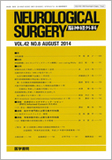Japanese
English
- 有料閲覧
- Abstract 文献概要
- 1ページ目 Look Inside
- 参考文献 Reference
Ⅰ.はじめに
もやもや病は両側内頚動脈終末部,前および中大脳動脈近位部が進行性に狭窄・閉塞し,その付近に異常血管網の発達を認める原因不明の特発性疾患である8,12).一方,動脈硬化や自己免疫疾患などの基礎疾患に伴って,血管撮影上もやもや病と同様の両側性内頚動脈病変を認める場合は,類もやもや病と診断される.脳虚血症状を有するもやもや病ならびに類もやもや病に対しては血行再建術が有効であり,高い治療効果が期待できる一方8),術後急性期の急激な脳循環動態の変化により脳虚血・過灌流症候群など多彩な病態を生じ得るため1,6),本治療における最大の課題は術後急性期の合併症回避といっても過言ではない.最近の周術期管理法の飛躍的向上により,もやもや病における血行再建術後の過灌流症候群は克服されつつあるが,動脈硬化や心疾患合併例など本来の周術期管理指針に沿った治療が困難な症例も存在するのが実情である.
今回われわれは,周術期管理に苦慮した動脈硬化を合併した成人類もやもや病の1例を経験したので,報告する.
A 42-year-old man with a history of hypertension and obesity presented with transient dysesthesia in his left upper and lower extremities and was found to have moyamoya syndrome associated with atherosclerosis. He underwent superficial temporal artery-middle cerebral artery anastomosis with pial synangiosis in the right hemisphere 1 month after the onset of symptoms. Prophylactic blood pressure lowering(<130mmHg)as well as minocycline administration was introduced immediately after surgery to prevent symptomatic cerebral hyperperfusion, but he developed pulmonary edema due to congestive heart failure several hours after surgery. We subsequently allowed his systolic blood pressure to be under 140mmHg, which dramatically improved his cardiopulmonary condition. The neurologic status of the patient was unremarkable, but 123I-IMP-SPECT the day after surgery demonstrated an intense increase in the cerebral blood flow at the site of the anastomosis. Moreover, postoperative magnetic resonance angiography demonstrated the bypass as thick, high signal. Together, these results led us to the diagnosis of cerebral hyperperfusion. The patient did not demonstrate any neurological sign during the entire perioperative period, but CT scan performed 7 days after surgery revealed a delayed intra-cerebral hemorrhage in the right temporal lobe due to the cerebral hyperperfusion. We continued to mildly lower his blood pressure, and neither ischemic nor hemorrhagic events were subsequently observed;he was discharged without neurological deficit 2 weeks after surgery. In conclusion, congestive heart failure and pulmonary edema are potential complications of the perioperative management of moyamoya syndrome with atherosclerotic background. Moreover, cardiopulmonary complications should be mentioned as a potential pitfall of the intensive perioperative management of moyamoya disease to counteract with cerebral hyperperfusion.

Copyright © 2014, Igaku-Shoin Ltd. All rights reserved.


